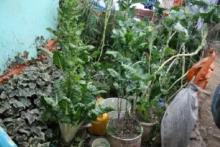Ethiopia: Greywater reuse interventions - keyhole and vertical gardens
Ethiopia: Greywater reuse interventions - keyhole and vertical gardens
| Title | Ethiopia: Greywater reuse interventions - keyhole and vertical gardens |
| Publication Type | Study report |
| Year of Publication | Submitted |
| Publication Language | eng |
| Abstract | Having a vegetable gardens at the homestead can help improve nutrition, while surplus may be an important source of income. Greywater is a valuable source of water in (semi) arid areas and helps reduce pollution of the compound. |
| Citation Key | 511 |
| Full Text | Having a vegetable gardens at the homestead can help improve nutrition, while surplus may be an important source of income. Greywater is a valuable source of water in (semi) arid areas and helps reduce pollution of the compound. The case study Greywater reuse interventions: keyhole and vertical gardens compares two practices of household gardening in which vegetables are watered using greywater (household wastewater from kitchen and washing).
The case study is part of the MUStRAIN case study series in which the uptake of Multiple Use Services (MUS) in different contexts within Ethiopia is being documented. The case studies analyse cost-benefit relations as well as opportunities and challenges for implementation of MUS. |

